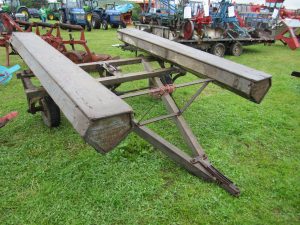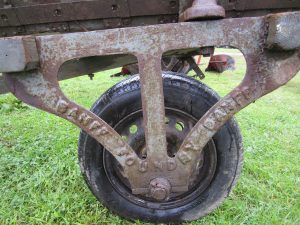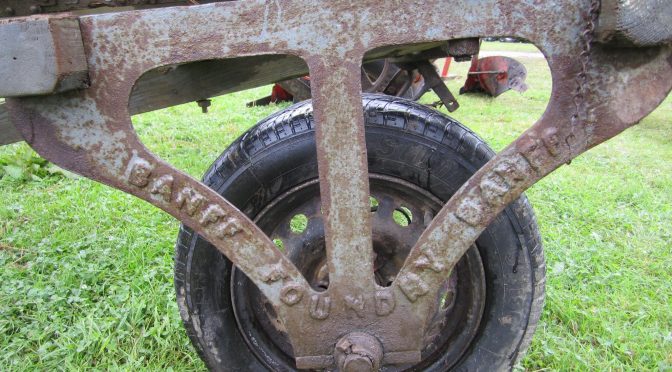The Banff Foundry was a well-known place for the manufacture of agricultural implements and machines in north-east Scotland. It had been home to a number of companies such as G. W. Murray. and later Watson Brothers.
 In 1924 there were to be further changes at the foundry with the emergence of the name of Banff Foundry and Engineering Company Limited. On 11 August 1924 this company became incorporated. Its headed notepaper stated “Banff Foundry & Engineering Co. Ltd, agricultural implement makers and engineers, incorporating G. W> Murray & Co. ltd, and Watson Bros. best 1820.”
In 1924 there were to be further changes at the foundry with the emergence of the name of Banff Foundry and Engineering Company Limited. On 11 August 1924 this company became incorporated. Its headed notepaper stated “Banff Foundry & Engineering Co. Ltd, agricultural implement makers and engineers, incorporating G. W> Murray & Co. ltd, and Watson Bros. best 1820.”
This company continued in business until 1951, when the directors passed a special resolution to voluntarily wind up the company. The final winding up meeting was held on 12 January 1962.
Its memorandum provides information on the formation of the new company and its activities:
“The objects for which the company is established are:
(1) To acquire and take over as a going concern the business now carried on at Banff by Robert Wood Hutcheson, Banff, and Alexander Grant, Dufftown, under the style or firm of “Watson Brothers”, and all or any of the assets and liabilities of that firm and with a view thereto to enter into and carry into effect with or without modification a minute of agreement which has already been prepared and is expressed to be made between the said Robert Wood Hutcheson and Alexander Grant of the first part and the company of the second part, a copy whereof has for the purpose of identification been signed by the subscribers hereto.
(2) To carry on business as-
(a) Founders, moulders, workers, fitters, and finishers in iron, brass, copper and other metals.
(b) constructors, repairers, owners, hirers, merchants and workers of agricultural, horticultural and forestry buildings, implements, tools, appliances and machinery.
(c) constructors and repairers, owners, hirers, merchants, brokers, and workers of ships, vessels, boats, docks, wharves, jetties and shipways and all machinery, accessories and appliances used in connection therewith.
 (d) constructors, repairers, owners, hirers, merchants, and workers of motor cars, motor lorries and other vehicles, locomotives, locomotive and other wagons, trucks, rolling stock, steam and road rollers and all machinery, accessories, and appliances used in connection therewith.
(d) constructors, repairers, owners, hirers, merchants, and workers of motor cars, motor lorries and other vehicles, locomotives, locomotive and other wagons, trucks, rolling stock, steam and road rollers and all machinery, accessories, and appliances used in connection therewith.
(e) constructors, repairers and merchants of roofs, bridges, and architectural and structural work in metal or other materials.
(f) constructors, repairers, owners, hirers, merchants and workers of electric, steam, gas, oil, hydraulic, hydrostatic, pneumatic, sanitary and water appliances, machinery, engines, and fittings and all accessories and appliance used in connection therewith.
(g) cartwrights, millwrights, wheelwrights, plumbers, carpenters, joiners, painters and general builders, makers, repairers and merchants of all kinds of fencing, wire, wire-netting and wire-work, metallurgists, iron and steel convertors and galvanisers, workers in wood, stone, brick, rubber and other substances, electricians, and producers and suppliers of electricity for the purpose of light, heat, motive power or otherwise, and manufacturers of and dealers in all apparatus and things required for or capable of being used in connection with the generation, distribution, supply, accumulation and employment of electricity, or gas, or other illuminant, or source of heat or motive power, blacksiths, machinists, and general engineers; draughtsmen, and pattern-makers, ship chandlers and dealers in ships stores, local and coke merchants, timber merchants, dealers in, manufacturers, blenders and refiners of petrol, fuel oil, lubricating oil and all other oils; manufacturers, repairers, merchants, owners and hirers of, and dealers in, all kinds of machinery, engines, boilers, tanks, valves, rivets, bolts, nuts, connections, plant, tools, apparatus and appliances.
And in connection with the above business to carry on any other business whether manufacturing, commercial, industrial, or otherwise, which may seem to the company capable of being carried on conveniently in connection with the above or calculated directly or indirectly to enhance the value of or render profitable any of the company’s property or rights, or which may be calculated directly or indirectly to benefit the company.”
The company had a share capital of £5,000, divided into 5,000 shares of £1 each. It was a small firm, but also one that was a common size for other implement and machine makers in Scotland.
Founding and other activities continued at the Banff Foundry after the Banff Foundry and Engineering Company Ltd wound up. A letter from that company proposed floating a new company known as Banff Foundry & Engineering Co. (1951) Ltd.
The Banff Foundry is a good example of a place where companies changed, as did their businesses, over the years, but where implement making was carried on over a number of generations by different makers.
